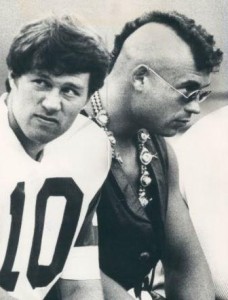20 Jan 15 Beast Modes
Everybody Needs A Good Ground Game
.
 Amid all the overwrought hype that surrounds the Super Bowl, it is sobering to remember that by some standards, the NFL really isn’t much. For instance, it generates far less money than most people think. The league and its members take in about $11 billion per year in gross revenues. That might sound like a lot, but not if you put it into context.
Amid all the overwrought hype that surrounds the Super Bowl, it is sobering to remember that by some standards, the NFL really isn’t much. For instance, it generates far less money than most people think. The league and its members take in about $11 billion per year in gross revenues. That might sound like a lot, but not if you put it into context.
For example, Washington state metal trades – an economic sector dominated by family-owned machine shops and metal fabricators – generated more than $11.7 billion in our state in 2013. That’s not just more revenue than was generated by the Seattle Seahawks. It was more than was generated by all 32 teams in the entire NFL.
Or, consider the relative impact of the larger economic sector, manufacturing, to which the metal trades belong. In 2013, manufacturing operations within the state generated $166 billion in revenue. That represented 24% of all private business revenue in the state, up from the 20% share generated by manufacturing 20 years ago.
Then again, when was the last time anybody paid to watch Uncle Buck guide the boys through their paces out in the fab shop?
And what’s up with the numbskulls who think the Seahawks might not bring back Beast Mode? THAT’S THE STUPIDEST THING WE EVER HEARD.
Forget 15 NFLs. Heck, give us 15 Beast Modes. Marshawn is the “manufacturing” of sports. Some in the sporting intelligentsia say he’s done, but he’s not only alive and kicking – he’s alive and kicking butt.
Proof came for the umpteenth time in the miracle finish to the NFC Championship Game Sunday. The miracle was the Seahawks still had a chance to win after nearly 60 minutes of play during a windy, rainy afternoon filled with miscues in the passing game. With a few minutes to go, the Seahawks were in it only because of the 157 yards gained throughout the game by Lynch as he paved another stretch of his very own Ibuprofen Highway.
Nitwits who claim he isn’t worth it usually cite the historic example of former Seahawk Shaun Alexander, a running back who cashed in at age 28, only to plummet in performance the following year. Lynch is 28 about to turn 29, therefore, his doubters believe he will soon be following Alexander in a mad dance to the sidelines.
That’s not “history.” It is “idiocy.”
In assessing Lynch, a better historic example is available and its not Alexander but a snot rocking power back blast from the past, John Riggins – also known as Riggo, AKA “The Diesel.”
The similarities are compelling.
Riggins and Lynch were both first round draft picks who wound up in the State of New York, Riggins with the Jets, Lynch with the Buffalo Bills.
A free spirit like Lynch, Riggins’s failure to blend in with the Jets was captured perfectly by the photo above. Riggo is the one with the Mohawk. It looks like he and his teammate didn’t share much more than their seats on the bench.
Like Lynch, after a few seasons Riggins was traded to another team, landing in Washington D.C. where he caught fire as “The Diesiel,” and forged a Hall of Fame Career.
Today, he is best remembered for a 43-yard, Beast Modely run for the winning touch down in the 1983 Super Bowl. View it here.
Riggins made that run when he was 33 years old. A year later, he had his best season, scoring a league record 24 touchdowns. That was at age 34. Granted, most running backs don’t perform like that at that age. But when was Riggins – or Lynch – like “most” backs? Neither was or is.
Riggins is also remembered for making headlines at the 1985 National Press Club banquet in Washington D.C. Seated at a table with US Supreme Court Justice Sandra O’Connor, Riggo drank too much. He famously suggested the Justice should “loosen up, Sandy baby” then slumped to the floor beneath their table and fell asleep.
Riggins was elected to the NFL Hall of Fame just a few years later.
Is this a great country, or what?
We say it is “great” and what would make it even greater is if the Seahawks sign up Marshawn for a couple more years – or three – and see what happens.
All this will be explored in greater depth next Tuesday, January 27, at the Annual Meeting of the Manufacturing Industrial Council. The meeting is scheduled for 3:30 to 5:30 p.m. in the auditorium at Colin Hall at South Seattle College in Georgetown. RSVP to tory@box2063.temp.domains.
Guest speakers will include Bill McSherry, a VP for Boeing Commercial Airplanes, who will provide an update on the State of Boeing. Also on the agenda is the project manager for the Alaskan Way Viaduct replacement project, Todd Trepanier. Trepanier will report on the State of Bertha, the deep-bore tunneling machine that could be in danger of boring no more.
Seattle Times publisher Frank Blethen was scheduled as the third guest speaker, but he is unable to attend and will now speak instead at the MIC meeting February 24.
Blethen’s slot will be filled by a State of Industry report that will clearly demonstrate the enormous contributions of basic industries to the good people who call Washington home.
In many ways, industry is our state’s socio-economic ground game: predictable, productive, nothing fancy, still going strong. Just like Marshawn.
